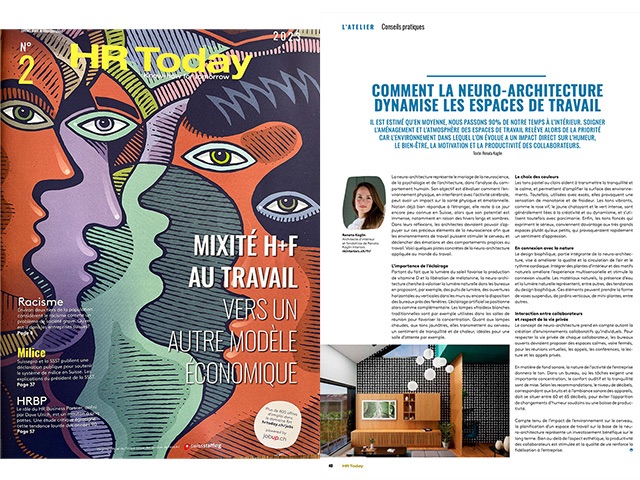Media
HR Today - How neuro-architecture makes workplaces more dynamic
May 2023 edition
It is estimated that on average we spend 90% of our time indoors. It is therefore a priority to take care of the design and atmosphere of the work space, as the environment in which we work has a direct impact on the mood, well-being, motivation and productivity of our employees.
Neuroarchitecture represents the marriage of neuroscience, psychology and architecture in the analysis of human behaviour. Its objective is to evaluate how the physical environment, by interfering with brain activity, can have an impact on physical and emotional health. Although this concept is already widespread abroad, it is still little known in Switzerland, even though its potential is immense, particularly because of the long, dark winters. Architects should be able to draw on this valuable neuroscience in their thinking so that working environments can stimulate the brain and trigger emotions and behaviours conducive to work. Here are some concrete ways in which neuro-architecture can be applied to the world of work.
The importance of lighting
Based on the fact that sunlight favours the production of vitamin D and the release of melatonin, neuro-architecture seeks to enhance the value of natural light in offices by proposing, for example, skylights, horizontal or vertical openings in the walls, or the arrangement of desks near windows. Artificial lighting is then positioned as a complement. Traditional "cold" white lamps are used in meeting rooms, for example, to encourage concentration. Warm, yellowish lamps, on the other hand, give the brain a feeling of tranquillity and warmth, ideal for a waiting room for example.
The choice of colours
Pastel or light colours help to convey tranquillity and calm, and amplify the surface of environments. However, when used excessively, they can make a room feel monotonous and cold. Vibrant tones, such as bright pink, shimmering yellow and intense green, are generally associated with creativity and dynamism, but are used sparingly. Finally, dark tones express seriousness and are more suitable for very large spaces than for small ones, which would quickly cause a feeling of oppression.
In touch with nature
Biophilic design, an integral part of neuro-architecture, aims to improve air quality and circulation and heart rate. Integrating houseplants and natural patterns enhances the multi-sensory experience and stimulates visual connection. Natural materials, the presence of water and natural light are among the trends in biophilic design. These elements can take the form of hanging vases, vertical gardens, mini-plants, among others.
Interaction between employees and privacy
The concept of neuro-architecture takes into account the creation of both collaborative and individual environments. To respect the privacy of each employee, open offices should offer quiet or even closed spaces for virtual meetings, calls, conferences, reading and private calls.
When it comes to background noise, the nature of the business will set the tone. In an office environment, where tasks require a high level of concentration, comfort and quietness are required. According to the recommendations, the decibel level, corresponding to the noise and the sound environment of the equipment, should be between 60 and 65 decibels, in order to avoid sudden mood changes or a drop in productivity.
Given the impact of the environment on the brain, planning a workspace based on neuro-architecture is a beneficial long-term investment. In addition to the aesthetic aspect, employee productivity is boosted and the quality of life increases loyalty to the company.
Check the full article (Comment la neuro-architecture dynamise les espaces de travail): https://www.hrtoday.ch/fr


